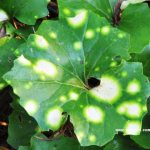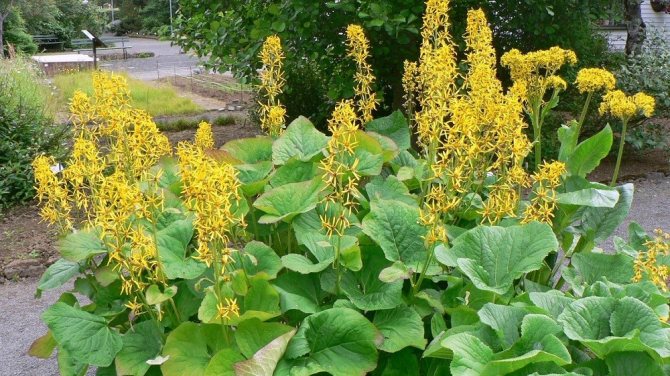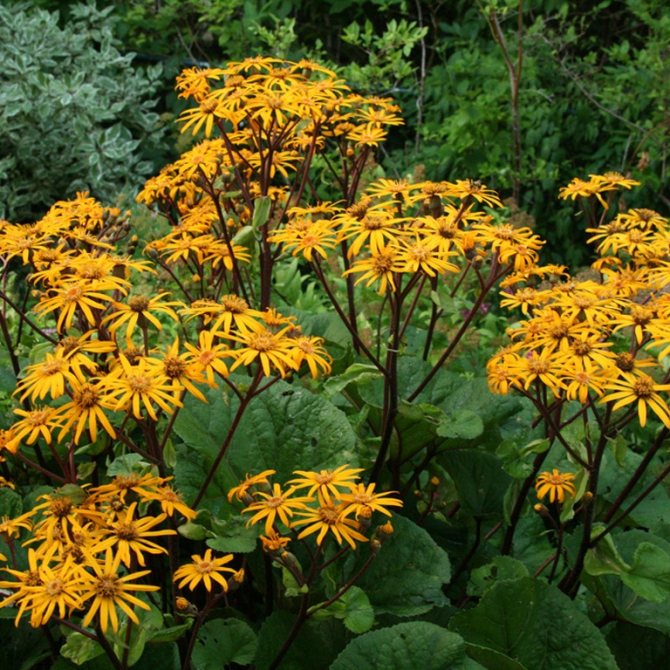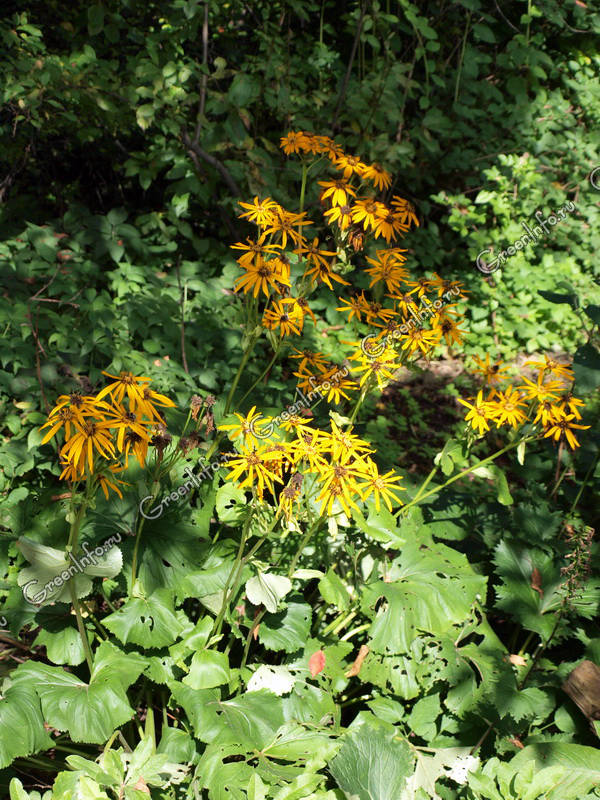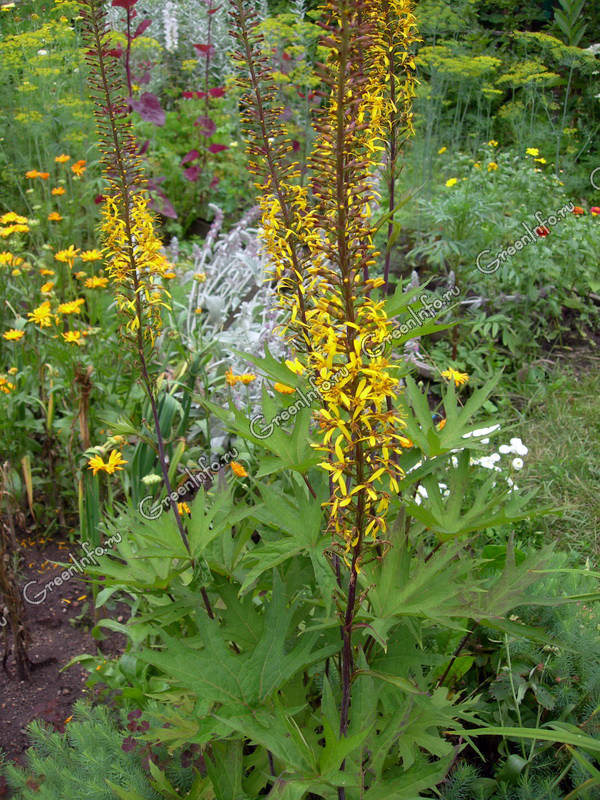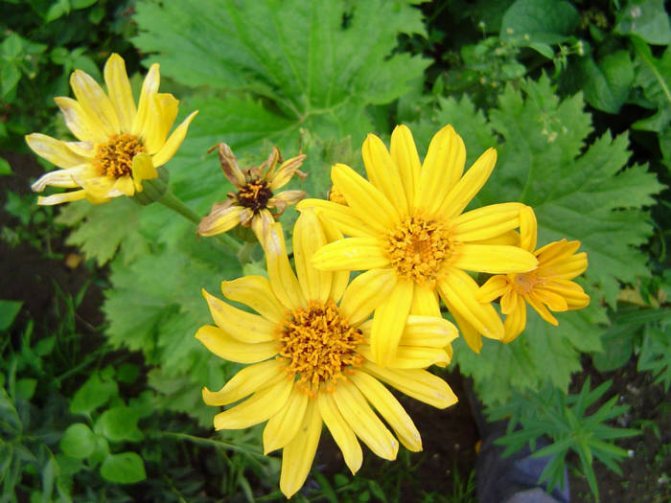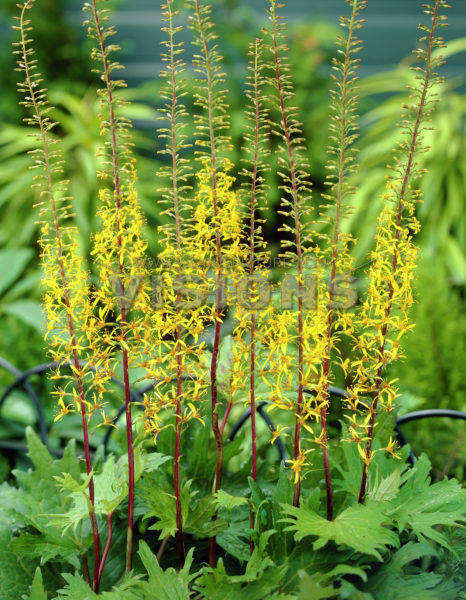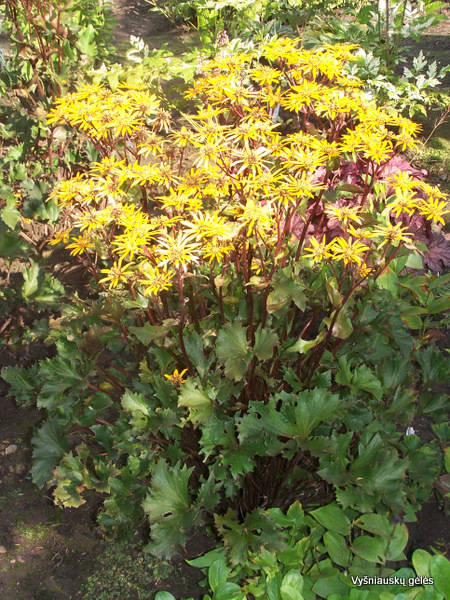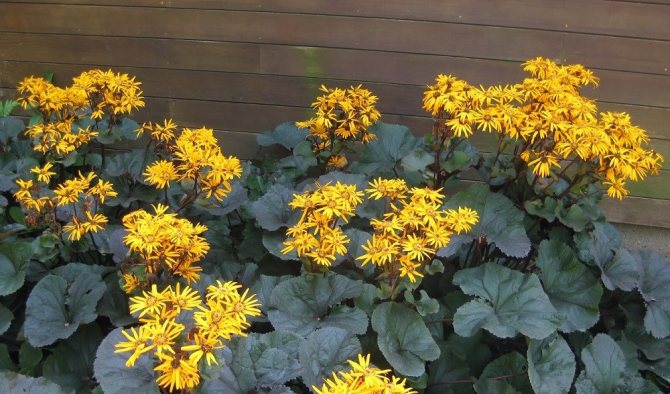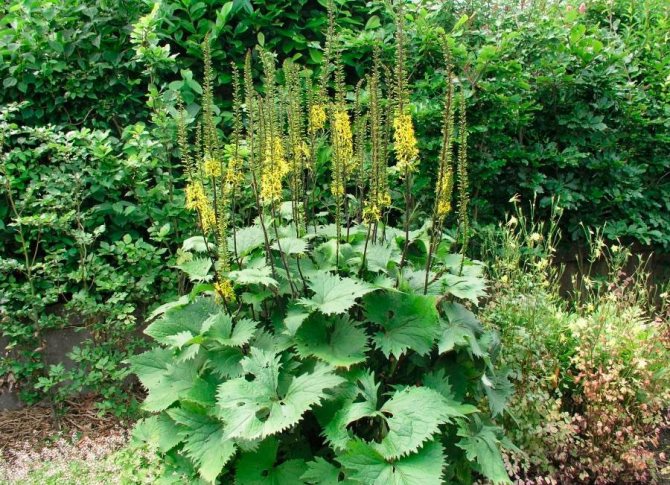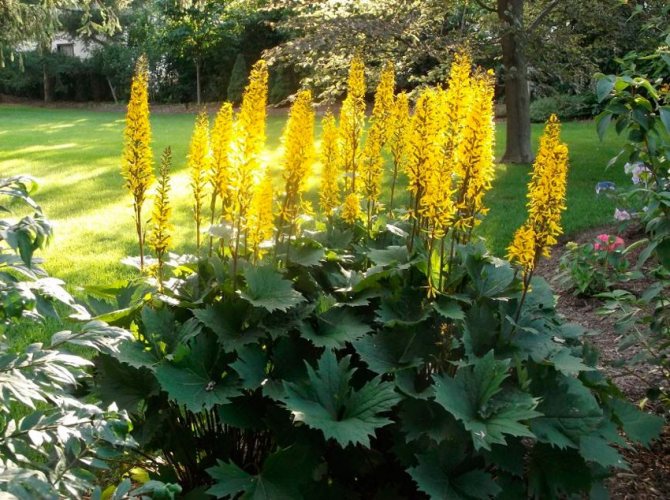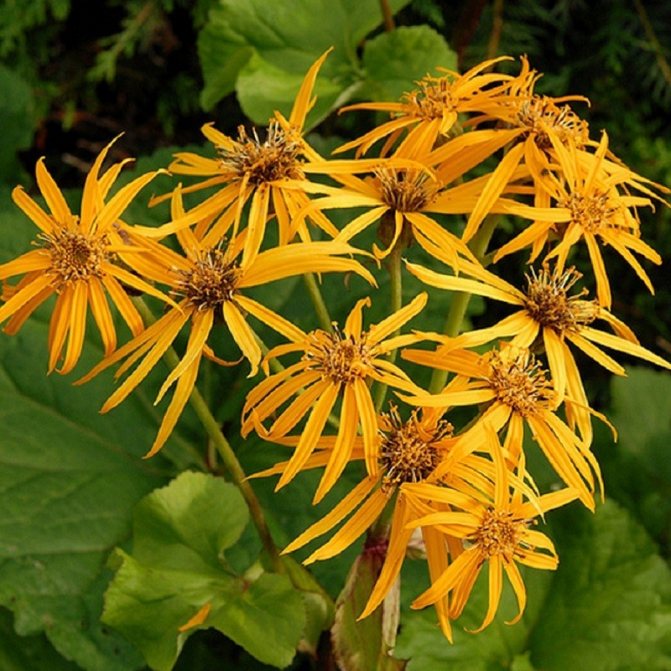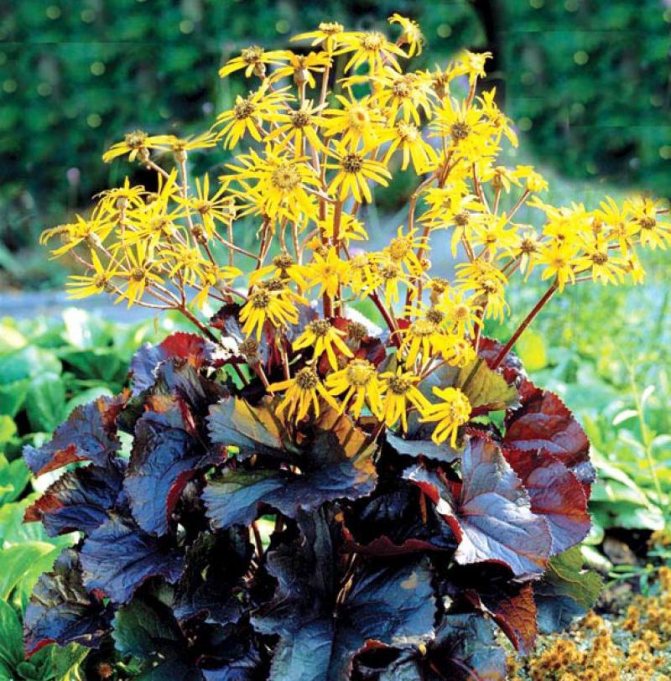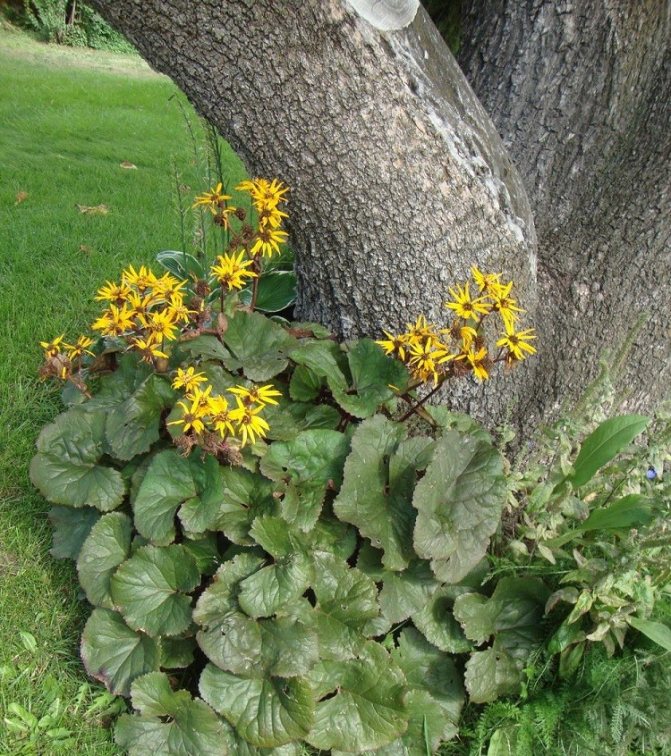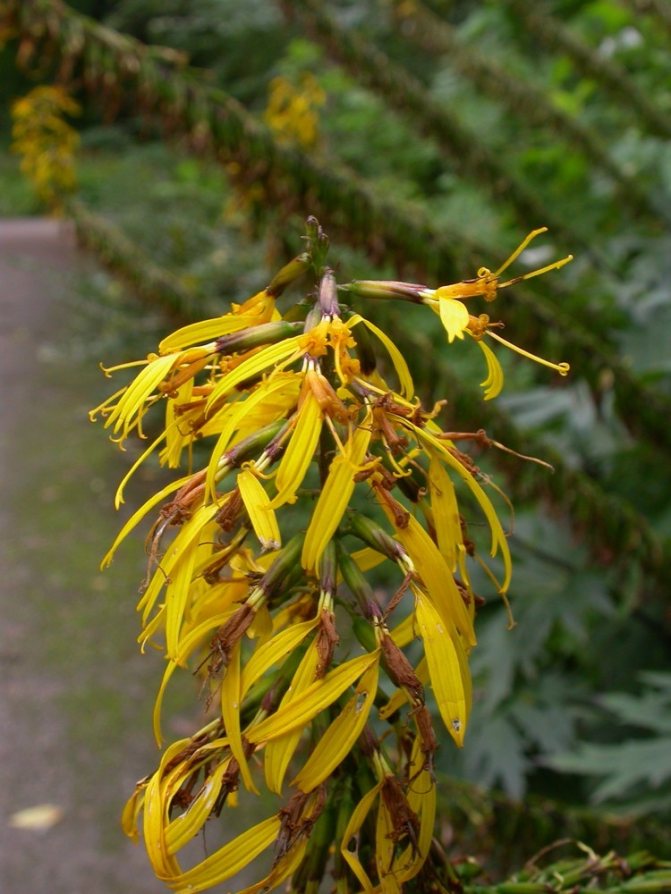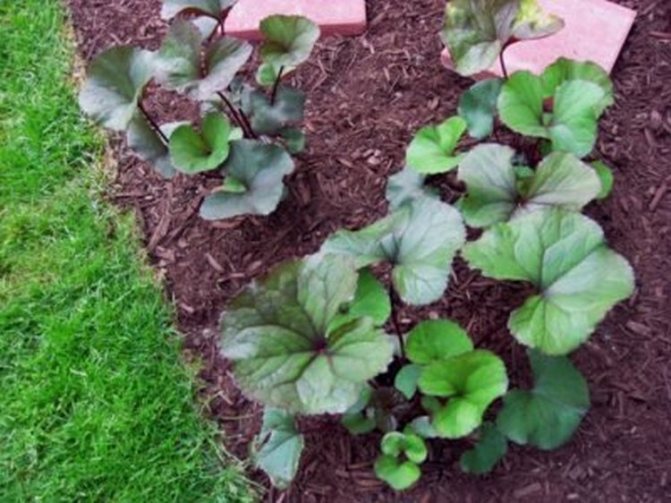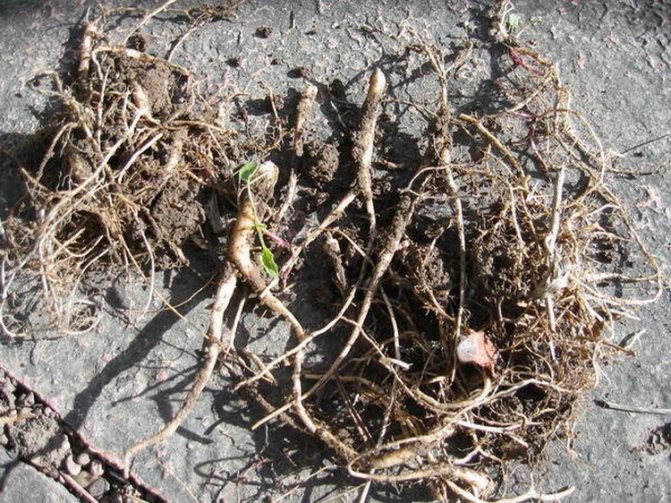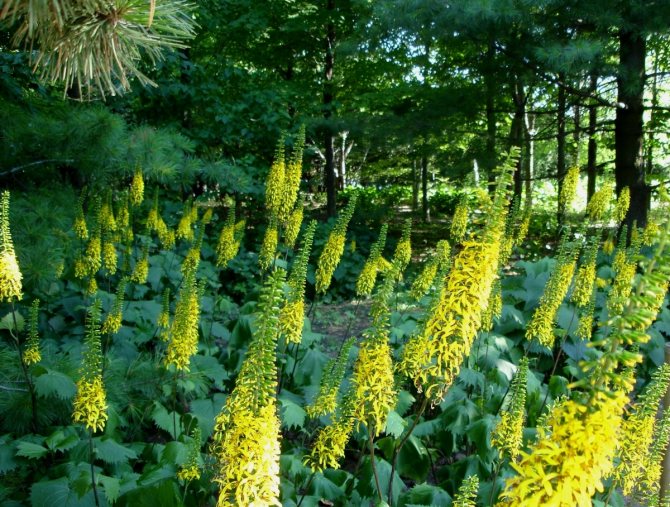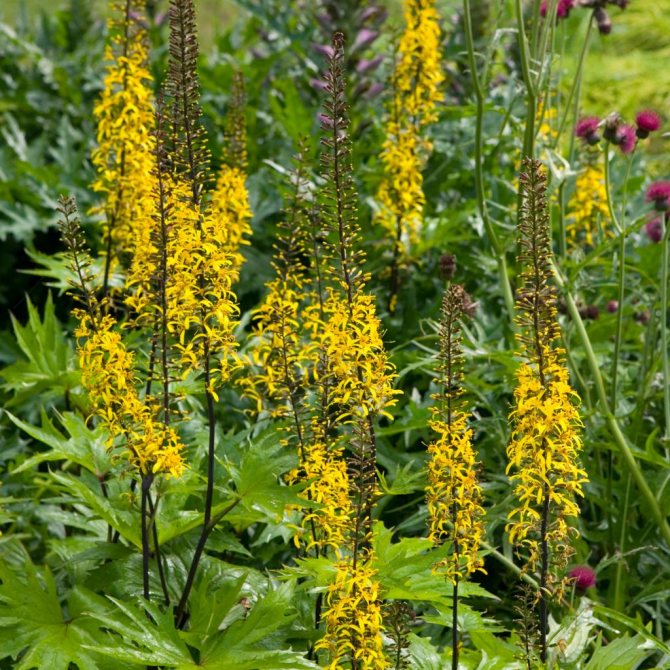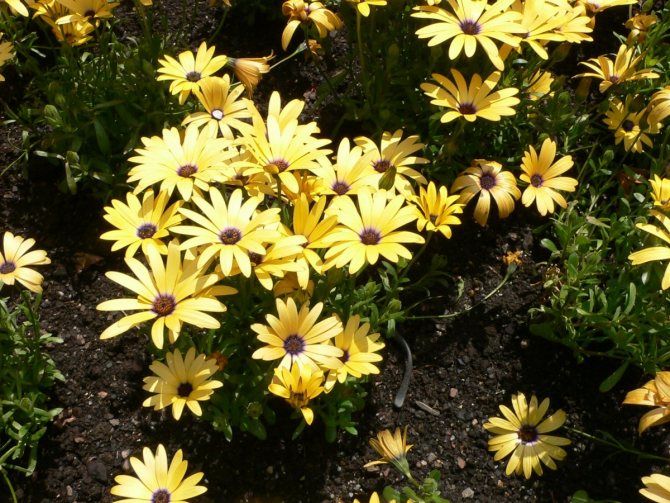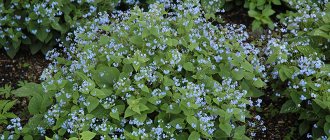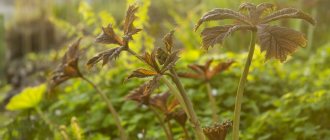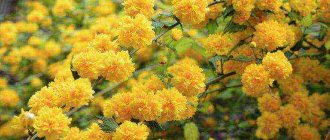Buzulnik (Ligularia) is a genus of herbaceous plants of the Aster family (Asreraceae). Of the 150 known representatives of the genus, there are only 10 in culture. Most of the species grow in the nature of East and Southeast Asia, the center of species diversity is in China.
The genus name is derived from the Latin ligula - language, the diminutive form of which, ligularia (tongue), indicates the curved shape of the reed flowers in the baskets, which look bright, but insignificantly compared to the dimensions of the whole plant. In the traditions of eastern countries, the buzulnik is often called the Tiger Plant - perhaps for the yellow-orange-brown tones of the inflorescences, reminiscent of the skin of a tiger, or perhaps for the spotted color of one of the unique, golden varieties of the Kempfer Buzulnik (Ligularia tussilaginea), or Japanese Farfugium.
Buzulnik Kempfer, golden uniform
Buzulniks are one of the largest herbaceous perennials, some species reach an impressive height of 2.5 m, but most are lower. Leaves are petiolate, collected in a basal rosette, rounded in outline, in some species, palmate. The color of the leaves is often two-colored, with a purple underside. Inflorescence - corymbose, racemose, spike-shaped or paniculate, blooms from bottom to top. The flowers are yellow or orange, sunny.
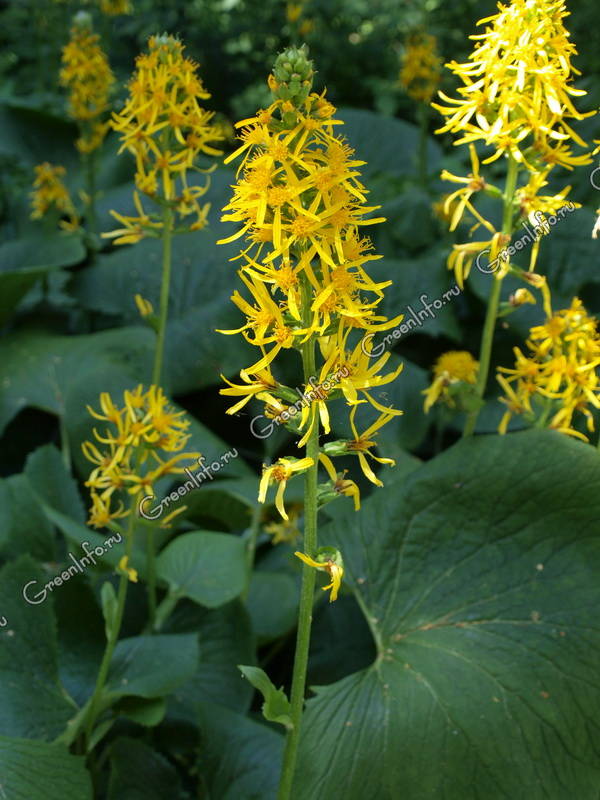
Buzulnik
These are majestic plants, so varied in appearance that they alone can be used to create a luxurious flower garden. They are especially good for yellow-red or yellow-purple compositions. They are completely undemanding to the growing conditions, they are not affected by diseases and pests (except for slugs and snails). The only thing they need is shade, on hot sunny days they suffer from dryness and wither. The best place for them is the shore of the reservoir, where the root system is well supplied with moisture, and the foliage thrives in the atmosphere of humid air, to which all Far Eastern plants are accustomed.
Only the range of Siberian buzulnik (Ligularia sibirica) covers not only the Far East and Siberia, but also sporadically - the European part of Russia. Also found in Central Europe. It is as rare in gardens as it is in our nature, although it has recently been suggested by some nurseries. This is a very decorative species from 40 to 150 cm tall, with heart-shaped, sometimes kidney-shaped or almost triangular leaves, medium-sized, up to 3 cm, baskets, collected in a simple racemose inflorescence. Peduncles with brown pubescence stand out beautifully against the background of greenery, and make yellow flowers more expressive.
Another Russian natural species is completely different from typical representatives of the genus - large-leaved buzulnik (Ligularia macrophylla), which grows in Western Siberia, Central Asia, and the Far East. Its large (up to 45 cm) oval leaves sticking up, more like horseradish leaves, only with a bluish bloom. It blooms from mid-July with medium-sized yellow flowers in loose panicles located on the tops of high, up to 1.5 m, peduncles. In culture, it is extremely rare, mainly in botanical gardens, although for decorative floriculture it is of interest for unusual foliage, as well as absolute winter hardiness. Better than other species, it tolerates an open location.
Buzulnik toothed (Ligularia dentata) is one of the most famous and widespread in culture. Up to 1 m tall, with large kidney-shaped, jagged edges, leaves on long petioles. Inflorescences - paniculate, of golden yellow, with a brown center, flowers up to 7-8 cm in diameter. It has several highly decorative and diverse varieties:
- Desdemona - up to 1.2 m tall, in spring the foliage is painted in beetroot color, later it becomes greenish-bronze, keeping the purple underside. The stems also have anthocyanin coloration. It blooms from late summer with orange-yellow flowers throughout the month.
- Оthello - very similar to the Desdemona variety, slightly lower (up to 90 cm), blooms earlier - in July, and not so abundantly.
|
|
- Britt-Marie Crawford - the darkest, most elegant variety about 1 m tall, with expressive "chocolate" leaves with a burgundy underside, bright throughout the season. It blooms from July for about a month with golden flowers.
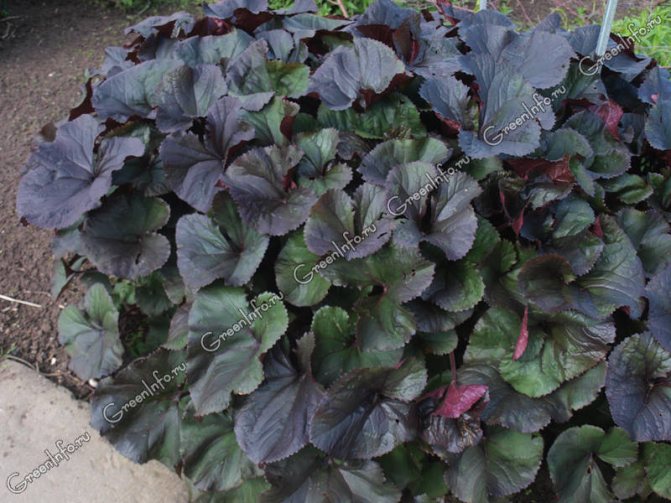

Buzulnik notched Britt-Marie Crawford
- Orange queen - up to 1 m, with green leaves, orange-yellow flowers, dark peduncles and a beautiful bush constitution.
- Dark beauty - 1.2 m tall, with large dark green foliage, which has a bright edging and purple underside, orange-yellow flowers with a characteristic crimson center.
Toothed buzulniks are responsive to fertilizing, but grow well on poor soils. Frost and winter hardy. They are durable, but without dividing they should not be grown for more than 5 years, otherwise cavities appear in the rhizomes.
Buzulnik Przewalski (Ligularia przewalskii) is one of the oldest and favorite garden plants. Up to 1.5 m in height. Graceful, with palmate-dissected leaves into sharp lobes, light spike-shaped inflorescences of yellow flowers on dark peduncles. The earliest (from June) and long-blooming (almost 2 months). Keeps a good company with B. toothed, contrasting with it the shape of foliage and inflorescences. It has the only drawback - from the end of July, the stems can fall apart in strong winds.
The hybrid received from him Light fingered the height is less, and the foliage is more delicate and deeply dissected, up to 25 cm wide. The peduncles are dark.
|
|
Narrow-headed Buzulnik (Ligularia stenocephala) is a Chinese species, 1.2-1.3 m tall. The leaf is cordate, irregularly indented, with large teeth. The inflorescence is pyramidal, reminiscent of B. Przewalski, but with larger flowers. Strictly erect, undemanding to conditions, like most buzulniks. It was used in many hybridizations, mainly with a closely related species - B. Przhevalsky, as a result of which popular varieties were obtained:
- The rocket - more than 2.5 m, with strong, not subject to winds, folded leaves, 40x25-30 cm in size. Candle inflorescences about 1 m high on thick peduncles turn into clubs by the end of flowering. In the fall, the leaves turn red.
- The little rocket - a more compact form, up to 1.8 m tall, with smaller leaves, dark peduncles and shorter inflorescences. Suitable for container growing.
- Weihenstephan - a hybrid obtained in 1970 in England. Tall, capable of reaching 80-175 cm, heart-shaped leaves, dark green, spike-shaped inflorescences, yellow. Winter-hardy up to -25 degrees.
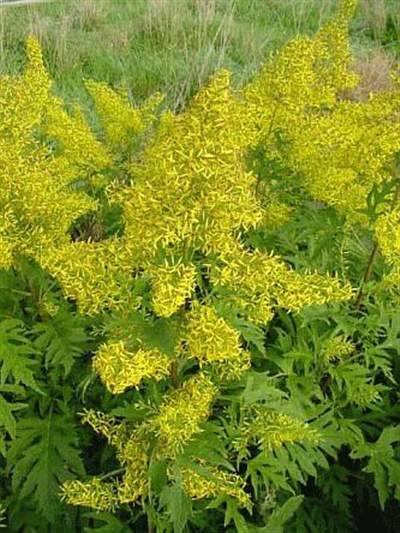

Buzulnik Tangut
Buzulnik Tangut (Ligularia tangutica) - also a Chinese species, 1-1.5 m high, most of all similar to B. Przhevalsky, but has a lighter and more delicate leaf 40x30 cm cut into narrow lobes and an exotic type of paniculate diamond-shaped inflorescence of small lemon flowers colors. In general, it resembles Volzhanka dioecious or giant astilba, only yellow. Early flowering, from the end of June for 1.5 months. Another distinctive feature of this species is the tuberous rhizome, which spreads stolons and "scatters" to the sides. Sometimes it should be limited, but the plant is easy to propagate vegetatively. It also reproduces by seeds, but does not give self-seeding.
Buzulnik Wilson (Ligularia wilsoniana) comes from Central China.Up to 1.5 m in height, it has candle-shaped yellow inflorescences, a changeable leaf shape, which can be cordate-pointed, cup-shaped, curved. It hibernates well, but it's still good for the winter to mulch for prevention.
Buzulnik Veitch (Ligularia veitchiana) is a powerful plant from Western China up to 2 m tall, with serrated heart-shaped leaves 50x40 cm, dark, shiny, elastic. The flowers are yellow, rather large, in beautiful spicate inflorescences. It looks especially radiant as a large curtain. It is winter-hardy enough, but preventive mulching is desirable in case of a winter with little snow.
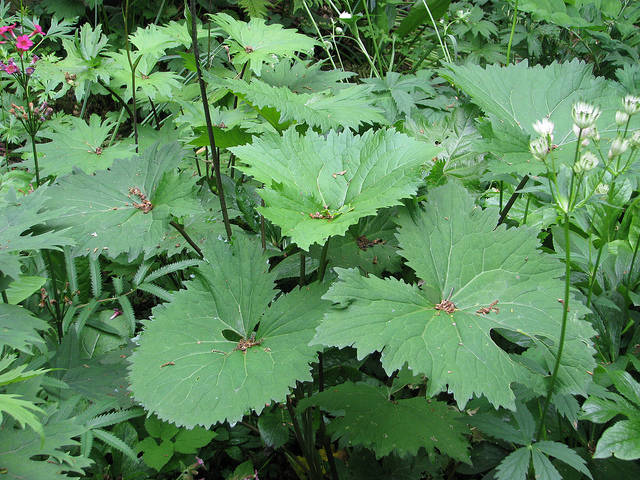

Buzulnik Vicha
Buzulnik Vorobyova (Ligularia vorobievii) - our Far Eastern species, over 2.5 m tall, green, with huge (about 40 cm in diameter) leaves, pubescent below. In buds, inflorescences are drooping. The flowers are chamomile-shaped, small, densely folded into candle-shaped, very beautiful inflorescences. Blooms in August. Winter-hardy, does not need mulching for the winter. It has been present in culture for a long time and has shown itself as a resistant plant. Propagated by dividing the bush and seeds. Seeds are light-sensitive, germinate unevenly.
Buzulnik Hessei (Ligularia x hessei) is a hybrid of toothed and Wilson's buzulniks. More than 2 m tall, all green, with heart-triangular leaves. Yellow baskets with a diameter of 8 cm are loosely located on the peduncle, forming wide candle-maces. Blooms throughout August. It goes very well with the dark leaves of other plants and the brown helenium flowers.
- Variety Gregynog gold - more than 1 m in height, has a dark green rounded wavy leaf and rich yellow flowers.
- Little lantern (syn. Laternchen) - differs in compact growth (up to 60 cm), darker leaves and shortened dense inflorescences.
Buzulnik Fisher (Ligularia fischeri) - a plant of Siberia, the Far East, China, Japan. Up to 1.5 m in height, all vegetative parts are green. Leaves of different shapes are combined on one plant. It blooms quite early, from late June to early July, throughout the month. Baskets are bright yellow, up to 6 cm in diameter, folded into a beautiful rare brush-"cap". Has a shortened rhizome, grows well.
Buzulnik Hodgson (Ligularia hodgsonii) - found in nature in China, Japan, the Russian Far East. Named after Brian Houghton Hodgson, a 19th century British amateur naturalist. Low-growing buzulnik, 50-60 cm, flowers 5-6 cm in diameter. Small plant for the foreground of a flower garden. Winter-hardy up to -31 degrees, it needs preventive winter protection.
|
|
Buzulnik palchatolobastny, or palm-shaped (Ligularia x palmatiloba syn. L. x yushizoeana) - is a hybrid of toothed buzulnik and Japanese. It has very large palmate, rounded leaves in outline and pale yellow flowers in loose racemose inflorescences that bloom in July. It does not tolerate dryness, more than other species it is sensitive to the sun and needs shade.
In addition to those already mentioned, there are a number of interesting hybrid buzulniks.
- Zepter - a hybrid of B. Vich with B. Przhevalsky, obtained a little more than 10 years ago, but has already managed to gain popularity. The height of 2.5 m, with candle-shaped inflorescences, is very reminiscent of B. Przewalski himself and The Rocket, from which it differs in a more cut leaf shape and very beautiful candle tips. Blooms for a very long time, blooms gradually. The foliage is green, the peduncles are dark, strong, not lodging, in contrast to B. Przhevalsky. It is easily pollinated, therefore it is propagated vegetatively.
- Granito - the plant is compact, rounded, 0.6 m in height and in diameter, with wavy large-toothed dark green leaves of variable color, covered with chartreuse or cream strokes and spots. Blooms in late summer. The flowers are golden, on purple-red peduncles. Winter hardiness up to -34 degrees.
|
|
The new Osiris series is unusual, but is characterized by late flowering and not very persistent color depending on light.
- Osiris Cafe Noir - toothed foliage, brown when blooming, then green with red veins, bronze-green by autumn.
- Osiris fantaisie - thick, rubbery-like, triangular-shaped leaves with a rough-toothed edge have a burgundy underside and purple-red stems. It blooms with golden yellow inflorescences.
- Osiris Pistache - variegated, with pistachio spots on a green background of kidney-shaped leaves.
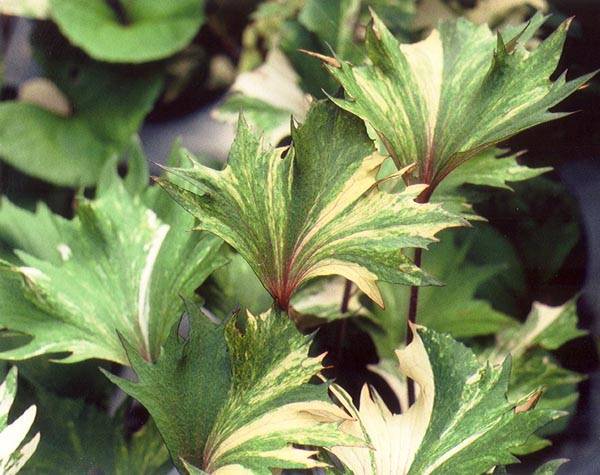

Buzulnik hybrid Osiris Fantaisie
Popular varieties and varieties with photos
In nature, there are almost 150 varieties and species of buzulnik, but only about 10 of them are cultivated:
Buzulnik Przewalski. The most popular species among gardeners. Its homeland is China and Mongolia. The height of the bush is 150 centimeters. The leaves are similar in shape to maple leaves. Inflorescences are spike-shaped. Flowering begins in June and lasts 60-70 days. Varieties of this type:
- Rocket. Peduncles up to 2 meters high, spike-shaped, bright yellow. The leaves are round, green in summer, crimson-burgundy in autumn.
- Maple-leaved. Peduncles are about 170 centimeters high. Maple-shaped leaves, large.
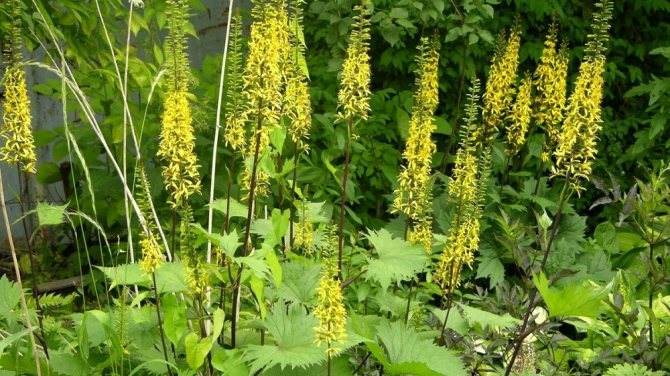

Buzulnik Przewalski
Buzulnik toothed. The birthplace of the species is Japan. Plant height 100 centimeters. The leaves are large, reniform. Flowers are in the form of baskets with a diameter of 7-8 centimeters, collected in paniculate inflorescences. The color is two-color: the center is brownish, the marginal petals are lemon yellow. Blooms in August. It has an average frost resistance, requires shelter for the winter. View varieties:
- Desdemona. The leaves are variegated: the top is light green, the bottom is purple with red veins. The flowers are bright yellow.
- Othello. The leaves are dark green above, purple below. The flowers are orange-yellow, collected in inflorescences with a diameter of 13-14 centimeters.


Buzulnik serrated grade Othello
Buzulnik Vorobyov. The birthplace of the species is China. The height of the bush is 2 meters, the diameter is 120 centimeters. The leaves are round, dark green, thick. Flowers are large, yellow, collected in a brush. Blooms in August.
Buzulnik Siberian. The height of the bush is from 30 to 130 centimeters. Leaves are cordate, up to 23 centimeters long. Flowers are collected in inflorescences from 5-50 baskets. The native land of the species is Siberia and Central Europe.
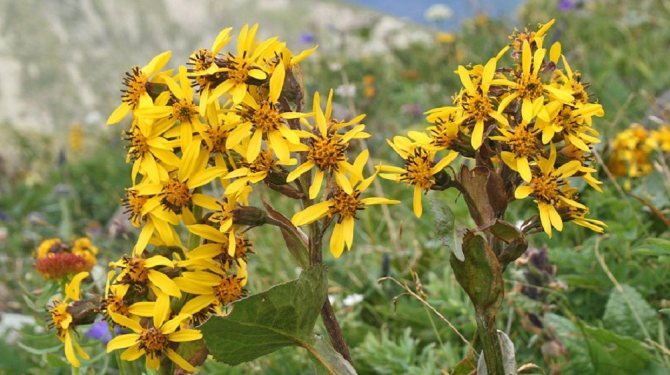

Siberian Buzulnik
Buzulnik Wilson... The birthplace of the plant is Central China. The height of the bush is 150 centimeters. The leaves are reniform, on long petioles. Blooms in July, with small yellow flowers.


Buzulnik wilson
Buzulnik Kempfer. Homeland - Japan. Stunted, no more than 50 centimeters. The leaves are large, oval in shape, with slightly serrated edges, up to 25 centimeters long. Lemon yellow flowers, collected in corymbose inflorescences.
Ligularia Vicha... Plant height is about 2 meters. Leaves are cordate. Up to 40 centimeters long. Inflorescences are spike-shaped. Consist of many basket-shaped flowers, yellow.
Ligularia Hessei... A hybrid of Cogwheel and Wilson. Leaves are elongated and cordate. Plant height is about 2 meters. Flowers are basket-shaped with a diameter of 5 centimeters, collected in loose shields.
Characteristics of the buzulnik: its description and features
Buzulnik has another scientific name - Ligularia. It is a perennial herbaceous ornamental plant that belongs to the large Asteraceae or Asteraceae family. Today this family includes a fairly large number of species - approximately 120-160. The natural habitat of this unusual flower is the territory of Asia, Europe and Africa. About 40 species of this plant grow in the wild on the territory of Russia. Buzulnik has recently become more and more popular among gardeners, as it is a rather attractive plant that can grow in the shade and has a fairly long flowering.
Translated from Latin, the scientific name "ligularia" means "tongues", which very accurately describes the appearance of a flowering plant. It is during flowering that flower stalks rise high above the foliage, bright yellow and orange flowers appear on them, like tongues of flame.
Due to its bright and very decorative appearance, Buzulnik is widely used in landscape design.
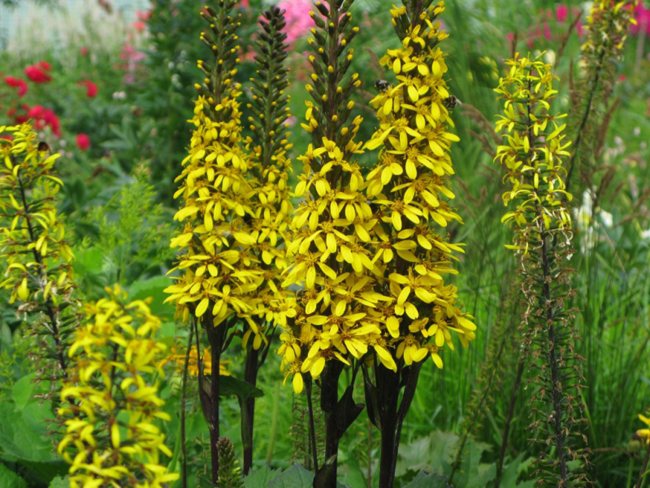

Buzulnik's description:
- This plant has great decorative value, which is brought to it by large green leaves and bright flowers.
- Buzulnik is a perennial plant that is grown in large quantities in Russia and other CIS countries, as it is quite hardy to the cold of a temperate climate.
- This flower can grow in one place for a very long time, without requiring a transplant.
- One of the features of the buzulnik is its shade tolerance and unpretentiousness to the soil, so it becomes indispensable for landscaping the site.
- The root system of the buzulnik is fibrous, very powerful. Individual roots can be up to 50 cm long.
- The plant itself can grow to a height of 130 cm.
- Buzulnik stems are represented by long petioles on which leaves are attached.
- Its leaves are very large, some specimens can reach 60 cm in diameter. Arranged in the next order, they create a basal rosette from which flower stalks grow.
- The leaves are green in color. Occasionally, the top of the leaf may have a greenish-purple hue, while the bottom may be slightly purple.
- Depending on the specific species, the leaves can be of various shapes: heart-shaped, triangular, oval, finger-divided.
- Long peduncles rise from the root outlet, the height of which can reach 1.5 m.
- Buzulnik bloom begins in June and lasts until September-October.
- Buzulnik flowers are small, nondescript, tubular flowers that are collected in inflorescences up to 10 cm in diameter. These inflorescences, in turn, are collected in racemose, spike-shaped or thyroid inflorescences, the flowering of which begins from the bottom up.
- The tubular flowers are inconspicuous, and the marginal ligulate flowers have a beautiful bright color - from yellow to orange, sometimes with a reddish and white tint.
- After the end of flowering, the fruits of the buzulnik appear on the peduncles, which are presented in the form of a crested achene.


Planting plants in open ground
Buzulnik is an unpretentious plant, but it needs careful preparation before planting. The result of growth and flowering depends on correctly performed planting and care procedures in the open field.


Buzulnik is one of the unpretentious garden plants to care for.
Selecting a seedling and preparing it for planting
It is recommended to buy a seedling in specialized nurseries or stores. With such a purchase, you can be confident in the variety of the plant, in addition, you can get advice on care.
When buying, evaluate the appearance of the seedling. It must have live, green shoots, strong, flexible roots. Depending on the intended planting site, a variety of a certain height is chosen.
Choosing a site for planting and preparing the soil
Buzulnik is not grown in areas completely open to the sun's rays. This plant needs shade or partial shade. It is realistic to grow a buzulnik in the sun, but in this case it will need to be watered abundantly daily. In addition, in the sun, the plant will lose its decorative effect: the color of the leaves will be simple, green, without shades of red or purple.
The ideal place is next to an artificial reservoir. In this case, the buzulnik does not even have to be watered, and it will always be in favorable conditions.
The soil for planting is dug up to 30 centimeters. To increase the nutritional value per square meter, a bucket of humus and a glass of superphosphate are introduced. To regulate acidity and disinfection, add 2 glasses of wood ash.
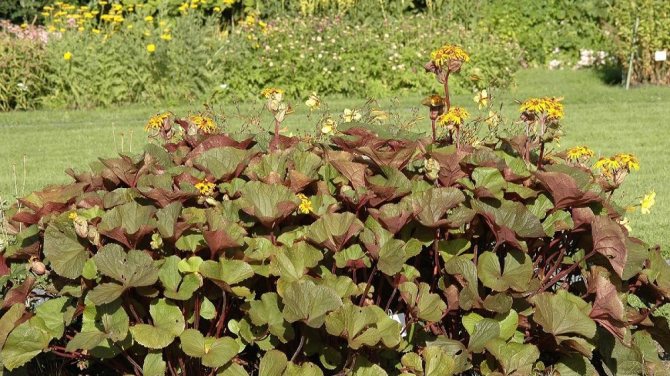

If the buzulnik grows in a sunny area, then the plant needs daily abundant watering.
Landing time and technology
Buzulnik planting time is early spring. This is the optimal time for the best adaptation of the seedling to new conditions. But if it is purchased in the summer, planting is also possible, but in this case, the peduncle and a third of the leaves are cut off from the buzulnik. It will take longer for the plant to take root during summer planting, but if there is enough moisture and good shading, it will adapt and start growing in a month.
For planting, a pit is prepared with a diameter and height of 40 centimeters. The distance between seedlings is from 1 meter. The seedling is placed in a hole so that the buds are above the surface. If all the recommendations are followed, the buzulnik will bloom in the same season.
Buzulnik planting technology
- Buzulnik seedlings are planted in early spring before the start of mass blooming of leaves.
- In a carefully prepared area, it is necessary to dig planting holes, the size of which should be 40 cm deep and 40 cm wide.
- If you are planting several buzulnik seedlings nearby, then remember that the bushes grow very quickly. Therefore, the landing pits must be made at some distance from each other. The approximate distance between two plants should be at least 1 m.
- Next, prepare a potting soil suitable for planting this crop. It should consist of fertile garden soil, 1 bucket of humus for each pit, superphosphate fertilizer, and some wood ash.
- If you are planting cuttings separated from the parent plant, then it is imperative to treat the cut areas with potassium permanganate or wood ash.
- Place seedlings in each planting hole and carefully sprinkle with soil mixture, lightly tamping with your hands. It is important that the kidneys are slightly above ground level - about 3-5 cm.
- Buzulnik saplings planted in spring can bloom this year.


Buzulnik care
Humidity, optimal illumination, top dressing - these are the three conditions for achieving the maximum decorative effect of the buzulnik. The plant is able to grow without leaving at all, but in this case it will not shine with beauty.
Irrigation rates
Buzulnik needs regular watering throughout the growing season, the frequency of which depends on the planting site:


Buzulnik needs regular watering
- if basul is planted in the shade of trees, watering is needed rarely, mainly at high air temperatures;
- when the plant is located next to a reservoir, watering is reduced to a minimum.
A plant planted in a sunny area requires much more water. In a dry summer, the buzulnik, in addition to watering, needs spraying. It is held in the evening after sunset.
The root of the buzulnik is located deep, so watering is necessary abundant, once a week. Simultaneously with watering, the soil is loosened and the surface is mulched to retain moisture.
Fertilizers and feeding
Buzulnik responds well to organic feeding and humus application
Buzulnik is distinguished by its rapid growth and the formation of a powerful root system, so the plant needs a large amount of nutrients. The main need of a plant is organic matter. With proper preparation of the pit in the first year, additional fertilizers are not applied under the plants.
From the second year, during spring loosening, half a bucket of humus is introduced into the soil for each bush. The first liquid top dressing is applied before flowering using a 1:10 mullein solution, that is, a liter can of concentrated infusion for 10 liters of water. The procedure is repeated every 2 weeks. For each bush, 3 liters of solution are consumed. Several times during the growing season, a glass of wood ash is poured under the bush.
Pruning and garter
The timely pruning of wilted flower baskets, dried leaves and damaged shoots helps to preserve the decorative effect of the buzulnik bush during the entire vegetative period. Autumn care consists in pruning the peduncles. Removing the peduncles helps to preserve the decorative foliage, which acquires an unusual color by autumn.
When grown in open areas, long peduncles are more likely to break. To prevent this from happening, it is recommended to build supports for the peduncles and tie the stems of the buzulnik to them. So that the shape of the bush is not disturbed, a free garter is needed.
Reproduction by dividing the bush
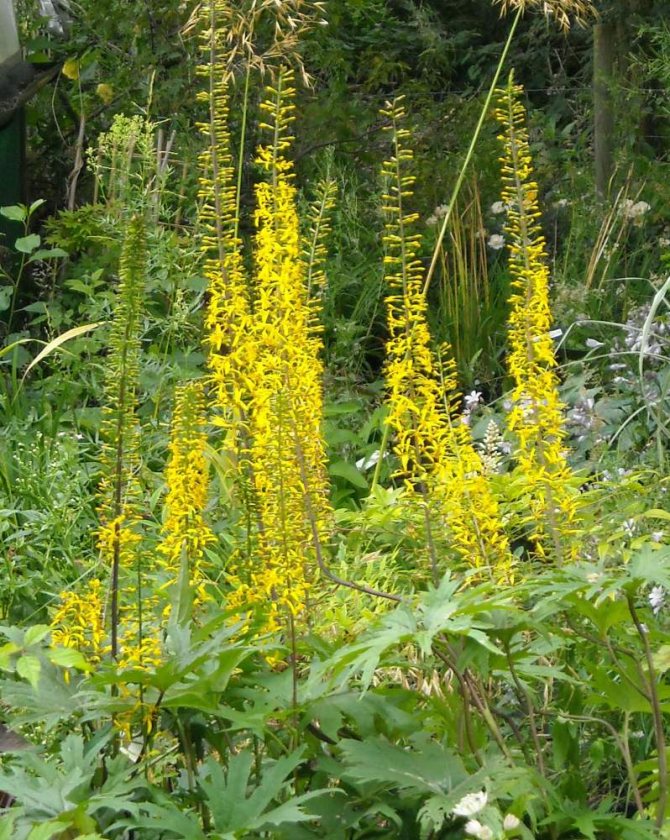

The most preferred and used method of propagation of Przewalski's buzulnik is dividing its bush. The advantages of this reproduction are simplicity and the ability to preserve the decorative characteristics of the main plant. By dividing the plant, flowering can be achieved as early as the next year after planting.
Division is carried out in the spring, in the phase of the most active growth. For this, the strongest and healthiest plant is selected, which has already begun to give leaves. It is not required to dig out the entire bush - it is enough to cut off a small part of the bush with a shovel. The space vacated after it must be covered with soil and thoroughly spilled with water. The separated part of the bush is cleaned and washed well. With a sharp knife, it is divided into several more parts, each of which must have at least two generative buds. After that, all sections must be treated with a manganese solution or ground charcoal. The finished planting material is sent to the prepared hole.
Diseases and pests
Buzulnik is rarely affected by diseases, and insect pests most often bypass it. But in conditions of high humidity, the leaves and stems are gnawed by slugs or snails. To protect against pests, use the drug Thunderstorm or Superphosphate granules.


Buzulnik rarely gets sick and is practically not affected by pests
In cold, damp weather, the buzulnik can become infected with powdery mildew. In this case, a white bloom appears on the leaves. The bush should be washed with a solution of potassium permanganate (2.5 grams per 10 liters), and then sprayed with a fungicide (Oxyhom, Hom, Topaz, Bordeaux liquid).
Some care tips
Somehow you don't need to take special care of the garden ligularia. In the spring, you can slightly loosen and mulch the soil around the plant, and in the summer you can provide sufficient watering. It's like an ultimatum of a plant - "More water!" A perennial needs this because its leaves are large and evaporate a lot of moisture. Inflorescences require a garter, because they can break under their weight or from the wind, especially bushes planted in an open, ventilated place need a garter. If the gardener is not going to harvest the seeds, the stems with wilted inflorescences are cut off after flowering. This causes the growth of the leaves of the plant, which are very beautiful until the very autumn. The aerial part of the flower at the end of autumn is usually not cut off, but if winter is expected to be frosty, then on the eve of autumn frosts it can be cut off - a "trimmed" bush will more easily endure frosts.
In the spring, it is advisable to add organic matter or nitrogen-type fertilizers, and before flowering - containing phosphorus and potassium. Ligularia is very sensitive to such feeding, but if the night and daytime temperature drops are very large, it is better to postpone the feeding. After five years, it is advisable to divide a large bush, since by this time the roots of the perennial will grow strongly and begin to "get out" from the soil. And the soil requires deep processing. In the fall, shortly before the cold weather, flower growers advise mulching the shrub, and in the spring, mix a layer of humus with the soil. The plant grows in the same place for about 6 years or more.
Buzulnik seed collection and preparation for winter
To collect seeds, several peduncles are not cut off. The inflorescences must be tied with gauze so that spontaneous rash does not occur, and left on the bushes for ripening. The peduncles are cut off before the onset of frost and brought into the house. After two weeks of drying, the seed pods are freed and winnowed. If winter sowing is not expected, the seeds are placed in paper bags and stored until spring in a dry, cool place.
Preparation of the buzulnik for winter begins in late autumn. With the onset of cold weather, the bush is freed from the aboveground part. Shoots are cut almost to the root. Despite its frost resistance, the roots of the buzulnik can suffer from frost in the absence of snow. The plant is mulched with humus, and if frosts come without snow, they are additionally covered with spruce branches or straw.
Pruning buzulnik in autumn
Buzulnik pruning is carried out when the plant fades. If the gardener needs seeds, leave a few paniculate inflorescences.
Pruning is done with the aim of transferring nutrients to foliage and branches, and not to faded flowers. This is necessary in order for the plant to grow foliage before the cold weather.
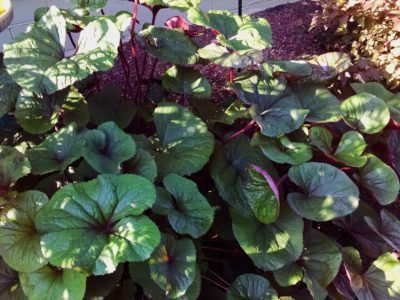

Buzulnik breeding methods
Buzulnik reproduces in two ways: by sowing seeds and dividing the bush. At the same time, the seed method is a rather time-consuming process and not entirely reliable.
Sowing seeds
Buzulnik can be propagated using seeds
A rather unreliable method of reproduction is sowing seeds. There are several reasons for this:
- Seeds often do not ripen and have poor germination. Seeds of varieties with purple leaves germinate especially poorly.
- Plants often do not retain varietal characteristics.
- Flowering of such a specimen begins only at the 5th year of its life.
Buzulnik from seeds is grown in a seedling and non-seedling way. The seeds can be sown outdoors in the fall. Sowing depth - 1-1.5 centimeters. In winter, the seeds undergo a natural stratification process.
Sowing should be carried out only after the onset of persistent cold weather so that the seeds do not germinate until spring. The number of seeds should be increased, since their germination percentage is low.
After sowing, the site is carefully covered with a layer of straw, sawdust or peat. In the spring, the shelter is removed before shoots appear. In the early days, seedlings must be shaded, otherwise the bright spring sun will burn the leaves.
In the process of growing, the seedlings are thinned out twice. The interval between procedures is 2 weeks. After the heat subsides, the sprouts are transplanted to a permanent place. But it is impossible to be late with the transplant so that the bush has time to take root before the onset of frost.
When sowing seedlings, the seeds must first be stratified in the cold for 60 days. In early March, seeds are sown in seedling containers. The seeds are embedded in the soil to a depth of 0.5 centimeters and covered with foil. After the first shoots appear, the film must be removed.
The picking of seedlings is not carried out, since the plant transplant is poorly tolerated. If the seedlings are too frequent, they are simply thinned out, leaving the strongest specimens. After preliminary hardening, the seedlings are planted in a permanent place.
Dividing the bush
The division of the bush is carried out in early spring before bud break
Reproduction by dividing the bush is carried out in the spring, when the first leaves appear. The bush is not completely dug up. A shovel is used to separate the part intended for transplantation. The part of the plant remaining in the soil is immediately covered up.
The separated part of the root is freed from the soil and washed with a disinfectant solution to prevent root rot. Delenka is planted in a permanent place in the usual way. The flowering of a bush propagated by division begins in the second year. The procedure for dividing the bush is not often carried out, but only after a significant growth of the buzulnik bush, as a rule, it is carried out once every 5 years.
Varieties
In our gardens, Przewalski's buzulnik cannot be found in its natural form, it can only be found in the collections of large botanical gardens. We are pleased with various cultivars of this perennial flower, obtained at different times by breeders from different countries. The most common are:
- Raketa is a cultivar of buzulnik with huge, up to two meters, peduncles, located on brownish-red sturdy stems and consisting of many small yellow "daisies". In addition, the leaves of such plants have a strongly indented edge, and not the entire surface of the leaf blade, and they are heart-shaped and more rounded in shape than representatives of other varieties.
- Maple-leaved - the name of the variety speaks for itself. Such perennials grow up to 1.7 m in height, and their leaves, which really resemble maple, are several times larger than those of the Raketa variety, and are up to 25 cm in diameter.
- Light Fingered is a fairly new variety that has not yet become widespread in Russian gardens. Its distinctive feature is a brighter color of flowers and rugged leaves.
Buzulnik in landscape design and in combination with other plants
In landscape design, buzulnik is widely used in single and group plantings, as a border. Wonderful neighbors of the hosta plant, daylily, cuff.
By combining different varieties of buzulnik in garden design, you can get whole walls for decorating tree trunks. High varieties of buzulnik in combination with undersized ones create original compositions in a natural natural style. The group planting of the buzulnik on the lawn looks beautiful.
You can get acquainted with the peculiarities of planting and caring for a buzulnik in the proposed video material. Happy viewing!
General information
The Latin name "ligularia" translated into Russian means "tongue". This name was given to the flower for a reason. It is a reflection of the shape of the marginal inflorescences of the buzulnik, which really look like tongues.
In nature, the plant grows in Asia and Europe. In the last decade, ligularia has become more and more popular with landscape designers and gardeners. It is so beautiful and unusual that it easily overshadows bright phloxes and peonies.
The plant prefers shaded areas, blooms for about two and a half months, and can grow in one place for a long time. Observing all the rules for caring for a plant, you can not only grow a beautiful flower, but also enjoy its flowering every summer.
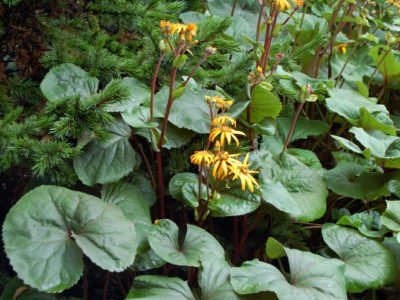

Such different ligularia
This decorative powerful flower, called ligularia in botany, belongs to the rather numerous (more than 150 species) Asteraceae (aster) family. Most of the plants belonging to this family are rhizome herbaceous perennials, popular in garden design. The stems of ligularia can grow up to 150 cm, and they are decorated with alternate, large (40-50 cm) leaves, which are different in shape: oval, rounded or sharp-fingered. Buzulnik Przewalski - the owner of a very beautiful openwork foliage.
As a rule, yellowish, orange or whitish flowers of ligularia are collected in corymbose, paniculate or racemose inflorescences.
When to collect and how to store buzulnik seeds
To correctly collect the seeds and not spill them on the ground, wrap the flower with gauze before it fades. After the plant has faded, cut off the wrapped inflorescences. Unroll the cheesecloth over a sheet of paper, shake off the seeds, sort out dry petals and dust that have fallen into it. When sowing before winter, spread the seeds on paper and leave until the procedure.
If you plan to sow buzulnik seeds in the spring, dry them on paper and transfer them to a cloth or paper bag.
Thyme or thyme? Or maybe thyme or Bogorodskaya grass? How is it correct? And right in every way, because under these names one and the same plant "passes", or rather, one genus of plants from the Lamiaceae family. There are many other popular names associated with the amazing property of this shrub to emit a large amount of aromatic substances. Growing thyme and using it in garden design and cooking will be discussed in this article.
Favorite Saintpaulias have not only a special appearance, but also a very specific character. The cultivation of this plant bears little resemblance to the classic care of indoor crops. And even relatives of the Uzambar violets from among the Gesnerievs require a slightly different approach. Irrigation is often referred to as the “weirdest” point of care for violets, which prefer non-standard watering to the classic method. But the approach will also have to be changed in fertilizing with fertilizers.
Useful, hardy, unpretentious and easy to grow marigolds are irreplaceable. These summers have long since moved from city flower beds and classical flower beds to original compositions, decorated the beds and potted gardens. Marigolds with their easily recognizable yellow-orange-brown colors and even more inimitable aromas are today able to pleasantly surprise with their diversity. Firstly, there are both tall and miniature plants among marigolds.
The system of protection of fruit and berry plantations is based on the use of mainly pesticides. However, if pesticides can be used in the protection of pome gardens during almost the entire growing season, taking into account the waiting period for each drug, then in the protection of berry crops they can be used only before the beginning of flowering and after harvesting. In this regard, the question arises which drugs should be used during this period to suppress pests and pathogens.
Our grandmothers, growing garden strawberries, or strawberries, as we used to call them, were not particularly worried about mulching. But today this agricultural practice has become fundamental in achieving high quality berries and reducing crop losses. Someone might say that it is troublesome. But practice shows that labor costs in this case are repaid a hundredfold. In this article, we invite you to get acquainted with the nine best materials for mulching garden strawberries.
Succulents are very diverse. Despite the fact that “babies” have always been considered more fashionable, the assortment of succulents that can be used to decorate a modern interior is worth taking a closer look at. After all, colors, sizes, patterning, degree of prickle, influence on the interior are just a few of the parameters by which you can choose them. In this article, we will tell you about the five most fashionable succulents that amazingly transform modern interiors.
Sponge cake with chocolate cream - light, fluffy and airy, with a delicate fondant cream based on milk powder, cocoa and cream. It will take very little time to prepare this dessert, and the products are simple, inexpensive and affordable. Homemade cakes for evening tea are pleasant and cozy moments of life that any housewife can organize for her family or friends-girlfriends. The coconut flakes in this recipe can be substituted for toasted walnuts.
It often happens that chemical insecticides, especially those that have been on the market for a long time, stop acting on pests due to the development of resistance (resistance) to the active substance, and then biological preparations can come to the rescue, which, by the way, have a number of advantages. In this article, you will find out how Lepidocide will protect vegetable, berry, ornamental and fruit crops from leaf-eating pests.
Mint was used by the Egyptians as early as 1.5 thousand years BC. It has a strong aroma due to the high content of various essential oils with high volatility. Today mint is used in medicine, perfumery, cosmetology, winemaking, cooking, ornamental gardening, and the confectionery industry. In this article, we will consider the most interesting varieties of mint, and also talk about the features of growing this plant in the open field.
People began to grow crocuses as early as 500 years before the advent of our era.Although the presence of these flowers in the garden is fleeting, we always look forward to the return of the heralds of spring next year. Crocuses are one of the earliest primroses that bloom as soon as the snow melts. However, flowering times may vary depending on species and varieties. This article focuses on the earliest crocus varieties that bloom in late March and early April.
Cabbage soup from early young cabbage on beef broth - hearty, aromatic and easy to prepare. In this recipe, you will learn how to cook a delicious beef broth and cook light cabbage soup in this broth. Early cabbage cooks quickly, so it is put into the pot at the same time as the rest of the vegetables, unlike fall cabbage, which takes a little longer to cook. Ready-made cabbage soup can be stored in the refrigerator for several days. The present cabbage soup turns out to be tastier than the freshly cooked one.
Blueberry is an uncommon promising berry crop in orchards. Blueberries are a source of biologically active substances and vitamins, have antiscorbutic, anti-inflammatory, antipyretic, restorative properties. Berries contain vitamins C, E, A, flavonoids, anthocyanins, trace elements - zinc, selenium, copper, manganese, as well as plant hormones - phytoestrogens. Blueberry berries taste like a mixture of grapes and blueberries.
Looking at the variety of tomato varieties, it is difficult not to get confused - the choice is very wide today. Even experienced gardeners are sometimes confused by it! However, it is not so difficult to understand the basics of selecting varieties "for yourself". The main thing is to delve into the peculiarities of culture and start experimenting. One of the easiest tomato groups to grow are varieties and hybrids with limited growth. They have always been appreciated by those gardeners who do not have a lot of energy and time to care for the beds.
Once very popular under the name of indoor nettles, and then forgotten by everyone, coleus today are one of the brightest garden and indoor plants. They are not in vain considered stars of the first magnitude for those who are looking primarily for non-standard colors. Easy to grow, but not so undemanding to suit everyone, Coleus require constant monitoring. But if you take care of them, the bushes of velvety unique leaves will easily outshine any competitor.
Salmon ridge baked in Provencal herbs is a "supplier" of tasty pieces of fish pulp for a light salad with fresh leaves of wild garlic. Champignons are lightly fried in olive oil and then poured with apple cider vinegar. These mushrooms are tastier than regular pickled mushrooms and are better for baked fish. Ramson and fresh dill get along well in one salad, emphasizing the aroma of each other. The garlic pungency of wild garlic will saturate both the flesh of the salmon and the pieces of mushrooms.
Buzulnik (from Latin ‘ligularia’ - “tongue”) is an unpretentious, beautiful plant with luxurious leaves and bright flowers, which is ideal for any garden. This is a rhizome plant of the Asteraceae family with erect stems and alternate leaves forming a spherical bush. Differs in abundant flowering. It blooms with yellow or orange daisies, collected in inflorescences (panicles). Depending on the variety, it can have a height of 15 to 250 cm. In its natural environment, it grows in the countries of the East and the South Siberian regions of Russia. Cultivated throughout Europe.
Buzulnik in garden design
Buzulniks, without problems, coexist with many other plants and are widely used in garden design. They are suitable for dense planting, in which plants shade each other, for planting in the background of a flower garden, along the house, on the shore of a reservoir, etc. Plants with red, purple or purple flowers, leaves of green and golden tones, etc. are chosen as companions for buzulniks.
Landing features
It is important to choose the right place for planting a buzulnik. He loves moist, fertile soil with a moderate amount of humus and partial shade.The plant, protected from the midday sun by the shade of trees or outbuildings, does its best. In a sunny place, without proper care, its leaves quickly lose their elasticity and look lethargic. The buzulnik is planted in a deep, well-fertilized hole approximately 40X40 cm in size.
Care
The main care of the buzulnik consists in timely watering, gentle loosening of the soil and protection from pests (the "main enemies" of the plant are snails and slugs, it is not immune to most diseases). Fertilize the soil periodically. Fertilizer mix can be purchased at a specialized outlet or prepared by yourself. For example, from sod land in equal proportions mixed with humus and a small amount of wood ash.
In central Russia, buzulniks winter without shelter.
Reproduction
Buzulnik propagates by seeds and division of the rhizome. Seed propagation is not difficult. In the spring, the collected seeds are laid out on the surface of the plot, pressed a little and sprinkled with a layer of earth slightly exceeding the thickness of the seeds themselves (in order to avoid problems, the seeds should not be embedded too deeply). Self-seeding of toothed buzulnik is possible. Reproduction by division is not difficult either: the prepared stalk is transferred to a previously prepared place and lowered into the hole. The land around the seedling is squeezed and watered abundantly. Crop care consists in maintaining soil moisture: daily irrigation with warm water and watering as needed. Seedlings should be watered carefully: both excessive dampness and drying out of the earth are equally dangerous for them. The best time for breeding buzulnik is spring, but planting in early autumn is also possible.
Varieties
By the variety of species, buzulniks are able to compete with any groups of plants. At the moment, more than 30 unique varieties and hybrids are known, differing from each other in many respects: shape, height, flowering time, etc. The most popular varieties are:
It differs not only in beautiful flowers, but also in a decorative rosette of heavily cut, graceful leaves on thin petioles of a red-brown hue. Height up to 150 cm. It blooms from the end of June with small yellow flowers, collected in racemose inflorescences.
Buzulnik Tangut
Not like any other! It has a thin carved leaf and a very delicate inflorescence. It blooms with lemon-yellow flowers, starting in August. In landscape design, it is usually used to combine several types of shrubs into a single composition.
Differs in large kidney-shaped leaves of a purple-violet hue and dark orange, collected in scutes, chamomiles. Reaches 1.2 m in height. It blooms from late July - early August for 30-45 days.
Buzulnik toothed Desdemona
Differs in large kidney-shaped leaves of a purple-brown hue and yellow-orange, collected in shields, chamomiles up to 7 cm in diameter. It reaches a height of 1 m. It blooms from late August to early September.
Buzulnik Vicha
It differs not only in bright yellow flowers, but also in a decorative rosette of leaves: large, dark, glossy, shaped like a heart. Can reach over 2 m in height. Flowering begins in August and lasts up to 40 days.
Buzulnik toothed Britt Mary Crawford
Unlike most other species, it withstands the sun well! Differs in the extraordinary color of the leaves: its leaves are chocolate-purple. It blooms with orange daisies starting in late summer.
Siberian Buzulnik
Differs in large heart-shaped green leaves. Blooms in yellow baskets gathered in a narrow raceme. Reaches a height of 1.40 m. Similar to it, but a dwarf species is called arctic buzulnik.
A hybrid of narrow-headed Buzulniks and Przewalski. In inflorescences it is similar to Przewalski's buzulnik, but has decorative foliage with larger teeth.
Buzulnik narrow-leaved Little Rocket
Ideal for growing in small flower beds, thanks to its medium height (up to 1 m)!
Thanks to such a variety of species, every gardener can decorate the garden and ensure flowering from June to October!
In the nature of central Russia, practically, with the exception of burdock, and, perhaps, hogweed, there are no particularly large plants. In the gardens and flower beds, you can see Przewalski's buzulnik - an elegant giant with bright yellow spike-shaped inflorescences and large carved leaves. This article will tell you what conditions this plant needs and what are the possibilities of using it in garden design.
Wilson Buzulnik (Ligularia wilsoniana)
This species is considered to be a native of Central China. The shrub is characterized by a height of up to one and a half meters, has upright branched shoots. Large lower leaves are kidney-shaped and attached to long petioles. Basket flowers form a large number of erect inflorescences. Flowering begins in mid-summer and lasts for 40 days. It tolerates low temperatures well. However, it is recommended to mulch the near-stem area to protect the root system from excessively high frosts. It prefers to be grown in semi-shady places near water bodies.
Content
- Listen to the article
- Description
- Planting a buzulnik Sowing seeds
- Transplanting and dividing the buzulnik bush
- Force majeure landing
- How to grow
- How and when to collect seeds
- Buzulnik Przewalski (Ligularia przewalskii)
Varieties of buzulnik: photo
Pest control
Most of all, ligularia are annoyed by mollusks - slugs and snails.
Fighting them with chemicals is undesirable due to their high toxicity. It is easier and safer to use the "old-fashioned" methods:
- manual collection;
- setting traps;
- construction of "obstacle course" - trenches or curbs-grooves from plastic bottles, where ash, hot pepper, lime is poured or chlorine-containing bleach is poured;
- prickly mulch (needles, nut shells, eggshells).
Application in medicine
Some varieties of the buzulnik plant are used in folk medicine. For example, an infusion is prepared on the basis of a gray-gray appearance, which helps to calm the nervous system with irritability, a bad psycho-emotional mood.
To prepare a tablespoon of the plant, pour a glass of boiling water, leave to infuse for 3 hours in a warm room, then strain. Consume one tablespoon three times a day on an empty stomach.
Also, gray buzulnik is used to combat arthritis. On its basis, you can make the following preparation: pour 2 tablespoons of herbs with 2 cups of water, put on fire and boil for 5 minutes, then leave for 2 hours, drain. Take a third of a glass three times a day.
A variety such as Fisher's Buzulnik helps in lowering body temperature. To prepare the medicine, pour a tablespoon of crushed inflorescences with 300 ml of boiling water, let it brew for 60 minutes, then strain. Drink half a glass three times a day.


Fisher's buzulnik helps in lowering body temperature
Buzulnik large-leaved (Ligularia macrophylla)
This plant can often be seen on the shores of water bodies and wet meadows. In the wild, it grows in Central Asia in the East and Siberia. It is characterized by elliptical leaves, which are attached to long petioles and have a grayish bloom. Leaf length 35-45 cm. Flowering begins in July and ends in early September. The racemose inflorescences are formed from a large number of yellow flowers in the form of baskets. The peduncle has a height of up to one and a half meters.The plant does not need shelter for the winter, as it tolerates low temperatures well. It is widely used to create a background for mexboders and flower beds.
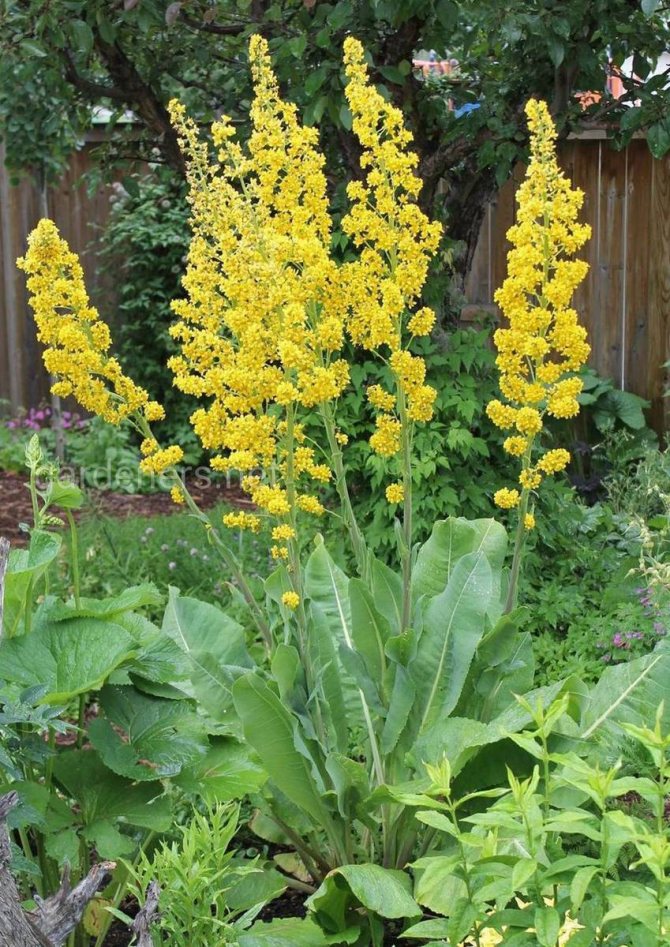

How to plant
There are two ways to plant a buzulnik:
- before winter with the help of seeds;
- in the spring by pre-growing seedlings.
The second method allows you to grow the plant faster, see flowering in the same year. But the first option is used most often, as it helps to harden the seeds, make the plant more resistant to low temperatures, weeds, and also achieve the development of a good root system.
For landing, choose a place where direct sunlight does not penetrate. After all, this culture adores partial shade, for example, it can be safely planted under trees. If there is a lot of sun, the decorative properties of the bush will be lost, you will have to water the soil too much.
Planting is carried out in moist and fertile soil. They pre-dig it, add humus and superphosphate.
RECOMMENDATION! (click to find out)
If the soil in the garden is too acidic, add wood ash.
Next, grooves are prepared, deepening by 1 cm. The distance between the plantings is maintained at 1 m. A closer planting is also allowed, but then thickets will turn out.
The required temperature for the growth of a buzulnik
Ligularia cannot stand hot, dry weather. This negatively affects her growth and appearance. But she easily tolerates a drop in air temperature. For germination of seeds of a newly planted plant, a sufficiently comfortable temperature is + 15-20C.


Buzulnik: briefly about the flower
The second name of Buzulnik is ligularia. It is a perennial plant from the Aster family. The height of the inflorescences can reach two meters, but there are also undersized varieties. The leaves are wide, powerful, like the plant itself, but at the same time the shrub takes on a very neat and elegant shape. Buzulnik will appeal to lovers of bright vegetation: its flowers are orange or yellow. The inflorescences are collected in dense baskets of flowers with rounded edges, rolled up like tongues (from this comes the Latin name for buzulnik - "lingularia", "tongue").
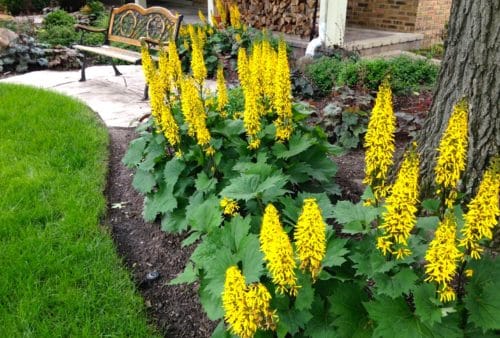

Buzulnik is a bright decoration of any garden
The homeland of the buzulnik is Southwest China, where the largest number of wild representatives of this flower grows. You can also find this plant in Russia: it prefers swampy meadows, the banks of streams and lakes. Siberian buzulnik grows there. Active breeding of buzulnik began relatively recently - at the beginning of the 20th century. New varieties are bred by breeders almost every year, and each of them differs in the shape of the leaves and colors.
Slugs are malicious pests


An important flower care is pest control. The most dangerous for the buzulnik are slugs. If the planting of flowers is close to the reservoir, if the place is wet, then slugs will come to visit. They gnaw large ugly holes on the leaves. They attack most often in spring and early summer, while the leaves are still young and tender. During this period, it is necessary to regularly inspect the plants in order to take action in time.
- If possible, slugs can be collected by hand. During the day, they hide under plants or on the underside of a leaf.
- You can arrange a barrier for them. Make grooves near the plants, which are covered with ash mixed with tobacco dust and river sand.
- You can sprinkle the ground around the buzulnik with superphosphate, but in this case it is important not to overdo it, because superphosphate is a fertilizer, its surplus is useless.
Narrow-leaved Buzulnik (Ligularia stenocephala)
North China is considered the homeland of this species. This shrub is very similar to Przewalski's Buzulnik, however, it has large flowers and serrated heart-shaped leaves. Breeders have developed a new hybrid variety based on this species, which they called Rocket.It is distinguished by small flowers, with a circumference of about 5 cm, which are attached to long two-meter peduncles of a dark green color. The leaves are heart-shaped, with cut edges and a dense texture. It tolerates winter frosts well. Leaves change their color to purple-crimson in autumn. Often it is an adornment of the banks of reservoirs and large flower beds.


Buzulnik Fisheras (Ligularia fischeri)
This species can very often be seen on the coast of reservoirs, in wet meadows and in thickets of bushes in Siberia, Mongolia, Japan, the Far East and China. This shrub grows up to one and a half meters in height. Differs in a shortened root system, erect stems, which are covered with brownish pubescence and hairs. Basal leaves form a rosette, heart-shaped. They can be spear-shaped or kidney-shaped. The length of the leaf is 10-20 cm, the width is 10-25 cm, the top can be pointed or rounded. Leaves are attached to thin long petioles. It blooms with yellow inflorescences collected from medium-sized baskets. Flowering begins at the end of July and lasts for 40 days. It prefers to grow on moist soils in semi-shady places. Often used to decorate coastal areas near natural or artificial water bodies.
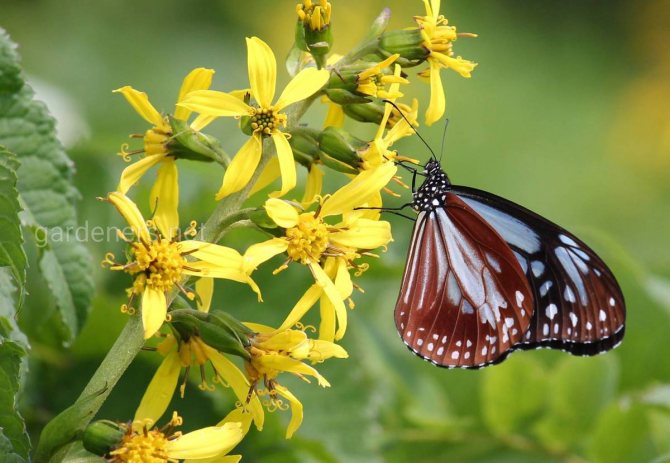

Where and how to plant?
It is important to note that Przewalski's buzulnik, planting and caring for which will be described below, can grow on almost any soil. Adequate moisture is essential for a good appearance and beautiful flowering.
This perennial can grow both in the sun and in the shade. Only such a flower - Przewalski's buzulnik - under direct hot sunlight does not look very good, to put it mildly: its leaves wither, and the whole plant looks dying. In fact, when the sun is gone, and the owner pours several buckets of water under the bush, the leaves will straighten out in half an hour, and he will look great. Of course, you can leave the plant like that, but it will develop much slower, and the flower-stalks will be somewhat smaller than that of a flower growing in a shady corner. That is why Przewalski's buzulnik is best planted under tree crowns, in partial shade and even in shaded areas of the garden.
Buzulnik Kempfer (Ligularia kaempfer)
This representative of the species is a native of Japan. It has a powerful root system, straight shoots, covered with a large number of rounded leaves with a diameter of 20-25 cm. The color of the leaves is green, the edges are serrated, the leaves are attached to long pubescent petioles. Flowering is observed in mid-summer. Bright yellow flowers with a circumference of up to 5 cm are attached to long half-meter peduncles and form thyroid inflorescences. This species has a subspecies that is grown in Russia and in coastal areas near the sea. It is distinguished by bright green leaves covered with spots of golden color. Flowering is observed in May and continues throughout the month.

